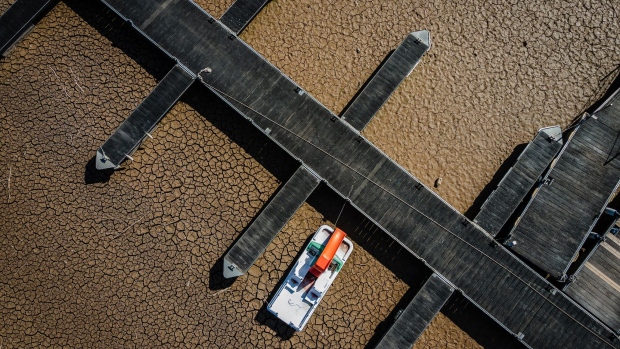Apr 5, 2023
A Spanish Reservoir Immortalized by Pop Rock Goes Dry
, Bloomberg News

(Bloomberg) --
The first few guitar chords were enough to make the crowd roar. Bodies swayed as the lyrics evoked a secluded valley in Catalonia whose reservoir was once a town; a church bell poking through the waters hinted at its former life. Everyone knew the pop-rock tune.
The year was 1998, the band was Sau and that hot summer concert was my first night out without parental supervision. As a young teenager in Spain I had developed for Sau — the band, the song and the reservoir, all bearing the same name — the kind of obsession only girls that age are capable of. So that night I sang and sweated, happy.
Those good times are gone, and not just because the band has disappeared, or because I’ve become an adult. Last month the Catalan government announced it was emptying and closing down the Sau Reservoir as water levels reached historic lows. Now, with less than 6% of water left, it’s not just the bell tower that’s visible, but the whole church of San Romà de Sau, the village flooded when the reservoir was built in the 1960s.
“Rainfall levels are at historic lows and the situation is critical,” Samuel Reyes, director of the Catalan water agency, told journalists in March. “Our worry is that we’re not at the end of a two-year drought, but in the middle of one that lasts three or four years.”
Governments in central and western Europe have started imposing restrictions to water use to guarantee supply for millions of people as the continent goes through its second consecutive year of drought. This dry and warm winter has parched soils, shrunk snow coverage and thinned rivers in Spain, France, the UK, northern Italy and Greece, according to Europe’s Copernicus agency.
Spring months are forecast to be warmer than average, with no end in sight for water shortage across the continent. Catalonia, a region in Spain’s northeast bordering France, experienced in 2022 its warmest year since record keeping by the Catalan meteorological agency started in 1917. Temperatures were 2.7 degrees Celsius higher in 2022 than the average between 1960 and 1990.
“This is an anomaly that we had forecast for 2050,” said Sarai Sarroca, the agency’s director. “This is a preview of what will happen in Catalonia over the next few decades.”
The region has been suffering from lack of rain for over two years, she said. That’s longer and more intense than the periodic droughts this part of the Mediterranean tends to experience. As a consequence, the region’s reservoirs did not replenish as they usually do over spring and autumn and are now below a third of their capacity.
Catalonia is not an isolated case. About two-thirds of Europe are being hit by the worst drought in at least 500 years, according to research by the Global Drought Observatory published last year. Europe is also warming more than twice the global average and last year was the fifth-hottest on record for the continent. Greenhouse gases emitted by human activities have warmed the planet by 1.1C since pre-industrial times.
Back in Sau valley, locals are bracing for an even tougher summer. The village of Vilanova de Sau draws most of its water from the reservoir. But as it empties, it will be left dependent on a well that has tended to dry out during the hottest months of the year. After that, the only solution left will be for water trucks to drive through the narrow, meandering road that connects the village with larger towns.
For many of Vilanova de Sau's 300 inhabitants, the reservoir is not just a source of water, but income too. The striking landscape and the band that made the reservoir famous during my teenage years made the whole area incredibly popular, drawing hundreds of visitors keen to rent kayaks and row around the church bell. This year, the owners of these businesses will have to look for alternative sources of income.
“I just hope it rains again because if it doesn’t, we’ll all die,” says Joan Riera, the village’s mayor. “I’m not pessimistic, of course I think it will rain again — the question is when.”
©2023 Bloomberg L.P.


